Numerical Investigation of the Performance, Hydrodynamics, and Free-Surface Effects in Unsteady Flow of a Horizontal Axis Hydrokinetic Turbine
Abstract
:1. Introduction
2. Methods
2.1. Governing Equations
2.2. Geometry and Computational Domain
2.3. Spatial and Temporal Discretization
3. Results and Discussion
3.1. Single-Phase Flow Simulations
3.2. Effect of Free Surface and Support Structure on Performance
3.3. Wake and Free Surface Interactions
4. Conclusions
Author Contributions
Funding
Institutional Review Board Statement
Informed Consent Statement
Data Availability Statement
Acknowledgments
Conflicts of Interest
Abbreviations
| HAHT | Horizontal Axis Hydrokinetic Turbine |
| HRIC | High Resolution Interface Capturing |
| SIMPLE | Semi-Implicit Method for Pressure-Linked Equations |
| MRF | Moving Reference Frame |
| TSR | Tip Speed Ratio |
| TSST | Transition Shear Stress Transport |
| URANS | Unsteady Reynolds Average Navier-Stokes |
References
- International Energy Agency. Available online: https://www.iea.org (accessed on 30 August 2021).
- Rogers, J.D. Celebrating Hoover Dam: The Majesty of Hoover Dam. Civ. Eng. Mag. 2010, 80, 52–65. [Google Scholar] [CrossRef]
- Suárez, B.; Vera Rodríguez, J.D.; Botero, F.; Suárez Agudelo, B.H.; Giraldo Jiménez, W. Hidroituango Intake Gate Closure—Emergency Conditions. Revista Facultad de Ingeniería Universidad de Antioquia 2021. Available online: https://revistas.udea.edu.co/index.php/ingenieria/article/view/344363 (accessed on 10 September 2021).
- Organization for Economic Co-operation and Development. Available online: https://stats.oecd.org (accessed on 28 August 2021).
- Anyi, M.; Kirke, B. Evaluation of small axial flow hydrokinetic turbines for remote communities. Energy Sustain. Dev. 2010, 14, 110–116. [Google Scholar] [CrossRef]
- Batten, W.; Bahaj, A.; Molland, A.; Chaplin, J. The prediction of the hydrodynamic performance of marine current turbines. Renew. Energy 2008, 33, 1085–1096. [Google Scholar] [CrossRef]
- Lee, J.H.; Park, S.; Kim, D.H.; Rhee, S.H.; Kim, M.C. Computational methods for performance analysis of horizontal axis tidal stream turbines. Appl. Energy 2012, 98, 512–523. [Google Scholar] [CrossRef]
- Batten, W.; Bahaj, A.; Molland, A.; Chaplin, J. Experimentally validated numerical method for the hydrodynamic design of horizontal axis tidal turbines. Ocean. Eng. 2007, 34, 1013–1020. [Google Scholar] [CrossRef]
- Danao, L.A.; Abuan, B.; Howell, R. Design Analysis of a Horizontal Axis Tidal Turbine. In Proceedings of the 3rd Asian Wave and Tidal Conference-AWTEC, Singapore, 24–28 October 2016. [Google Scholar]
- Bowman, J.; Bhushan, S.; Thompson, D.S.; O’Doherty, D.; O’Doherty, T.; Mason-Jones, A. A physics-based actuator disk model for hydrokinetic turbines. In Proceedings of the Fluid Dynamics Conference, Atlanta, GA, USA, 25–29 June 2018. [Google Scholar]
- Silva dos Santos, I.F.; Camacho, R.G.R.; Filho, G.L.T. Study of the wake characteristics and turbines configuration of a hydrokinetic farm in an Amazonian river using experimental data and CFD tools. J. Clean. Prod. 2021, 229, 126881. [Google Scholar]
- Mikkelsen, R. Actuator Disc Methods Applied to Wind Turbines. Ph.D. Thesis, Technical University of Denmark, Lyngby, Denmark, 2003. [Google Scholar]
- Sørensen, J.N.; Shen, W.Z. Numerical Modeling of Wind Turbine Wakes. ASME J. Fluids Eng. 2002, 124, 393–399. [Google Scholar] [CrossRef]
- Henao Garcia, S.; Benavides-Morán, A.; Lopez Mejia, O.D. Wake and Performance Predictions of Two- and Three-Bladed Wind Turbines Based on the Actuator Line Model. ASME J. Fluids Eng. 2021, 143, 051206. [Google Scholar] [CrossRef]
- Baba-Ahmadi, M.H.; Dong, P. Validation of the actuator line method for simulating flow through a horizontal axis tidal stream turbine by comparison with measurements. Renew. Energy 2017, 113, 420–427. [Google Scholar] [CrossRef] [Green Version]
- Hocine, A.E.B.L.; Jay, R.W.; Poncet, S. Multiphase modeling of the free surface flow through a Darrieus horizontal axis shallow-water turbine. Renew. Energy 2019, 143, 1890–1901. [Google Scholar] [CrossRef]
- Bahaj, A.; Molland, A.F.; Chaplin, J.R.; Batten, W.M.J. Power and thrust measurements of marine current turbines under various hydrodynamic flow condition in a cavitation tunnel and a towing tank. Renew. Energy 2007, 32, 407–423. [Google Scholar] [CrossRef]
- Yan, J.; Deng, X.; Korobenko, A.; Bazilevs, Y. Free-surface flow modeling and simulation of horizontal-axis tidal-stream turbines. Comput. Fluids 2017, 158, 157–166. [Google Scholar] [CrossRef]
- Kolekar, N.; Vinod, A.; Banerjee, A. On Blockage Effects for a Tidal Turbine in Free Surface Proximity. Energies 2019, 12, 3325. [Google Scholar] [CrossRef] [Green Version]
- Nishi, Y.; Sato, G.; Shiohara, D.; Inagaki, T.; Kikuchi, N. Performance characteristics of axial flow hydraulic turbine with a collection device in free surface flow field. Renew. Energy 2017, 112, 53–62. [Google Scholar] [CrossRef]
- Bai, X.; Avital, E.J.; Munjiza, A.; Williams, J.J.R. Numerical simulation of a marine current turbine in free surface flow. Renew. Energy 2014, 63, 715–723. [Google Scholar] [CrossRef]
- Adamski, S.J. Numerical Modeling of the Effects of a Free Surface on the Operating Characteristics of Marine Hydrokinetic Turbines. Master’s Thesis, University of Washington, Seatle, GA, WA, 2013. [Google Scholar]
- Rodríguez, L.; Benavides-Moran, A.; Laín, S. Three-Bladed Horizontal Axis Water Turbine Simulations with Free Surface Effects. Int. J. Appl. Mech. Eng. 2021, 26, 187–197. [Google Scholar] [CrossRef]
- Hirt, C.W.; Nichols, B.D. Volume of fluid (VOF) method for the dynamics of free boundaries. J. Comput. Phys. 1981, 39, 201–225. [Google Scholar] [CrossRef]
- Menter, F.R. Zonal two equation k-turbulence models for aerodynamic flows. In Proceedings of the 23rd Fluid Dynamics, Plasmadynamics and Lasers Conference, Orlando, FL, USA, 6–9 July 1993. [Google Scholar]
- Contreras, L.T.; López, O.D.; Laín, S. Computational fluid dynamics modelling and simulation of an inclined horizontal axis hydrokinetic turbine. Energies 2018, 11, 3151. [Google Scholar] [CrossRef] [Green Version]
- Langtry, R.B.; Menter, F.R. Transition Modeling for General CFD Applications in Aeronautics. In Proceedings of the 43rd AIAA Aerospace Sciences Meeting and Exhibit, Reno, NV, USA, 10–13 January 2005. [Google Scholar]
- Langtry, R.B.; Menter, F.R.; Likki, S.R.; Suzen, Y.B.; Huang, P.G.; Völker, S. A Correlation-Based Transition Model Using Local Variables—Part II: Test Cases and Industrial Applications. ASME J. Turbomach. 2006, 128, 423–434. [Google Scholar] [CrossRef]
- Rezaeiha, A.; Montazeri, H.; Blocken, B. On the accuracy of turbulence models for CFD simulations of vertical axis wind turbines. Energy 2019, 180, 838–857. [Google Scholar] [CrossRef]
- Arab, A.; Javadi, M.; Anbarsooz, M.; Moghiman, M. A numerical study on the aerodynamic performance and the self-starting characteristics of a Darrieus wind turbine considering its moment of inertia. Renew. Energy 2017, 107, 298–311. [Google Scholar] [CrossRef]
- Almohammadi, K.M.; Ingham, D.B.; Ma, L.; Pourkashanian, M. Modeling dynamic stall of a straight blade vertical axis wind turbine. J. Fluids Struct. 2015, 57, 144–158. [Google Scholar] [CrossRef]
- Laín, S.; Taborda, M.A.; López, O.D. Numerical study of the effect of winglets on the performance of a straight blade Darrieus water turbine. Energies 2018, 11, 297. [Google Scholar] [CrossRef] [Green Version]
- López, O.; Meneses, D.; Quintero, B.; Laín, S. Computational study of transient flow around Darrieus type Cross Flow Water Turbines. J. Renew. Sustain. Energy 2016, 8, 014501. [Google Scholar] [CrossRef]
- Myers, L.; Bahaj, A.S. Near wake properties of horizontal axis marine current turbines. In Proceedings of the 8th European Wave and Tidal Energy Conference-EWTEC, Upsala, Sweden, 7–10 September 2009. [Google Scholar]
- Waclawczyk, T.; Koronowicz, T. Comparison of CICSAM and HRIC high-resolution schemes for interface capturing. J. Theor. Appl. Mech. 2008, 46, 325–345. [Google Scholar]
- El Fajri, O.; Bowman, J.; Bhushan, S.; Thompson, D.; O’Doherty, T. Numerical study of the effect of tip-speed ratio on hydrokinetic turbine wake recovery. Renew. Energy 2022, 182, 725–750. [Google Scholar] [CrossRef]
- Tian, W.; Ni, X.; Mao, Z.; Zhang, T. Influence of surface waves on the hydrodynamic performance of a horizontal axis ocean current turbine. Renew. Energy 2020, 158, 37–48. [Google Scholar] [CrossRef]
- Wen, B.; Wei, S.; Wei, K.; Yang, W.; Peng, Z.; Chu, F. Power fluctuation and power loss of wind turbines due to wind shear and tower shadow. Front. Mech. Eng. 2017, 12, 321–332. [Google Scholar] [CrossRef] [Green Version]
- Müller, S.; Muhawenimana, V.; Wilson, C.A.M.E.; Ouro, P. Experimental investigation of the wake characteristics behind twin vertical axis turbines. Energy Convers. Manag. 2021, 247, 114768. [Google Scholar] [CrossRef]
- Myers, L.; Bahaj, A.S. Experimental analysis of the flow field around horizontal axis tidal turbines by use of scale mesh disk rotor simulators. Ocean. Eng. 2010, 37, 218–227. [Google Scholar] [CrossRef]
- Silva, P.A.S.F.; De Oliveira, T.F.; Junior, A.C.P.B.; Vaz, J.R.P. Numerical Study of Wake Characteristics in a Horizontal-Axis Hydrokinetic Turbine. Ann. Braz. Acad. Sci. 2016, 88, 2441–2456. [Google Scholar] [CrossRef] [PubMed] [Green Version]
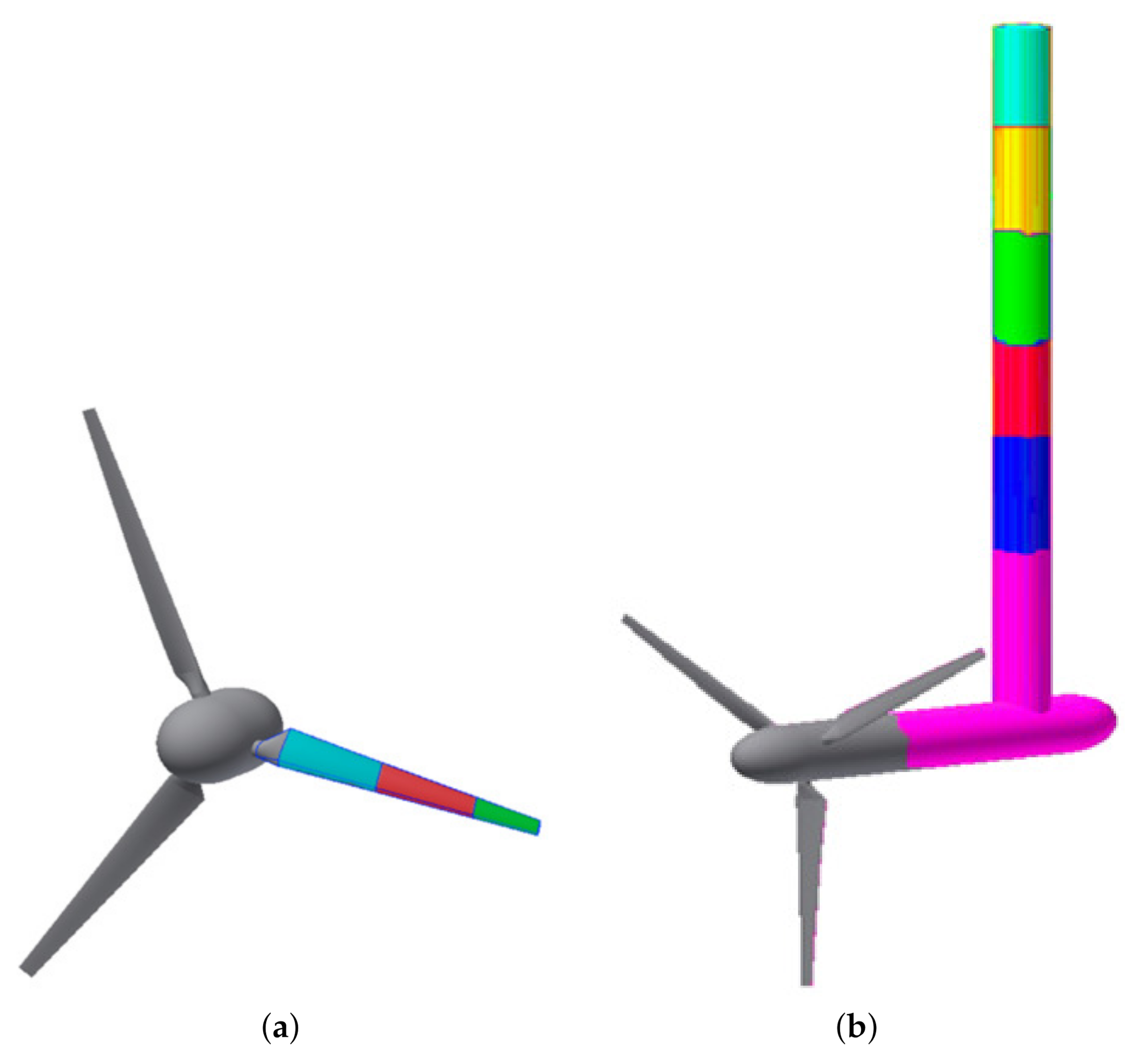

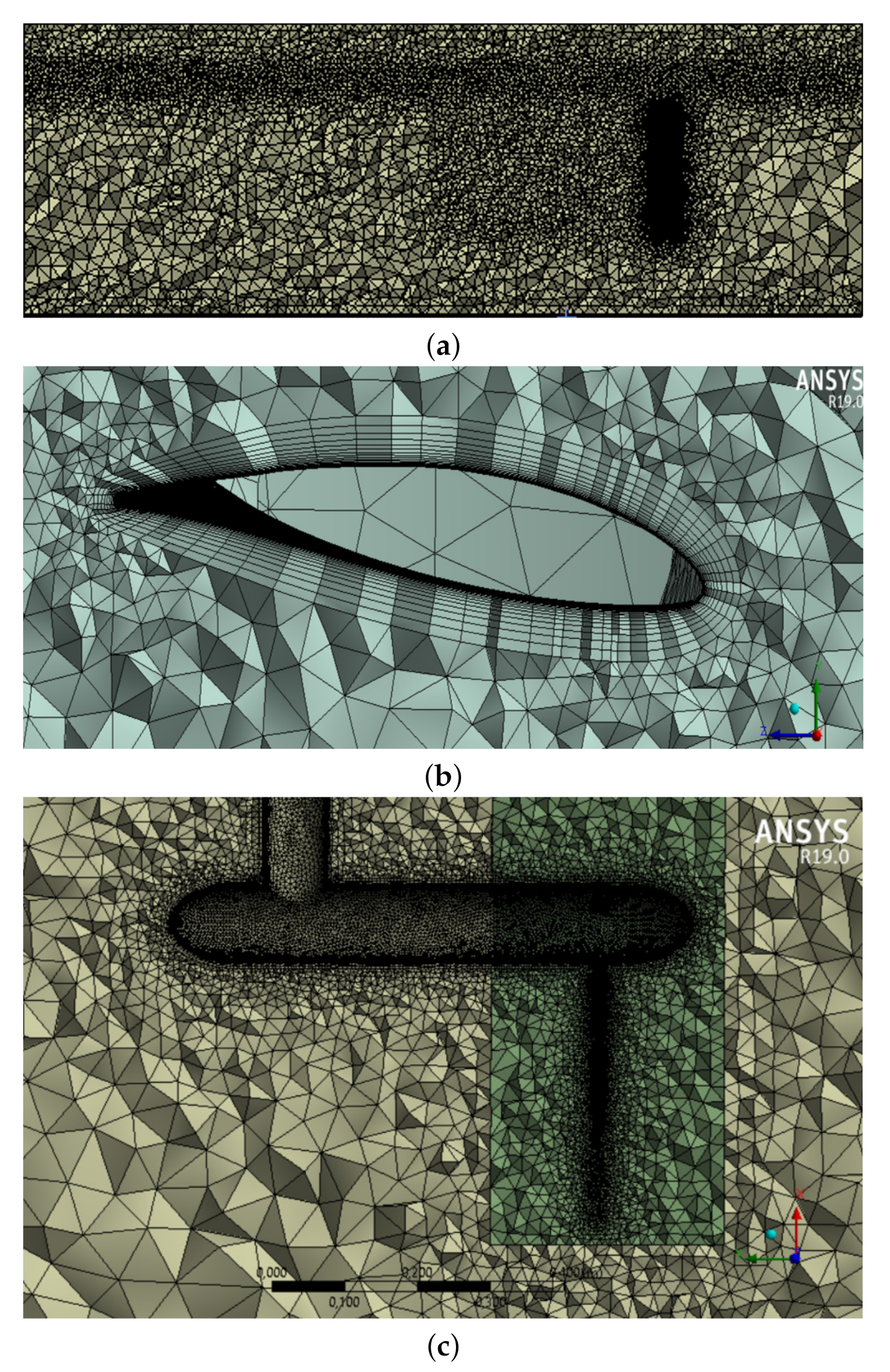
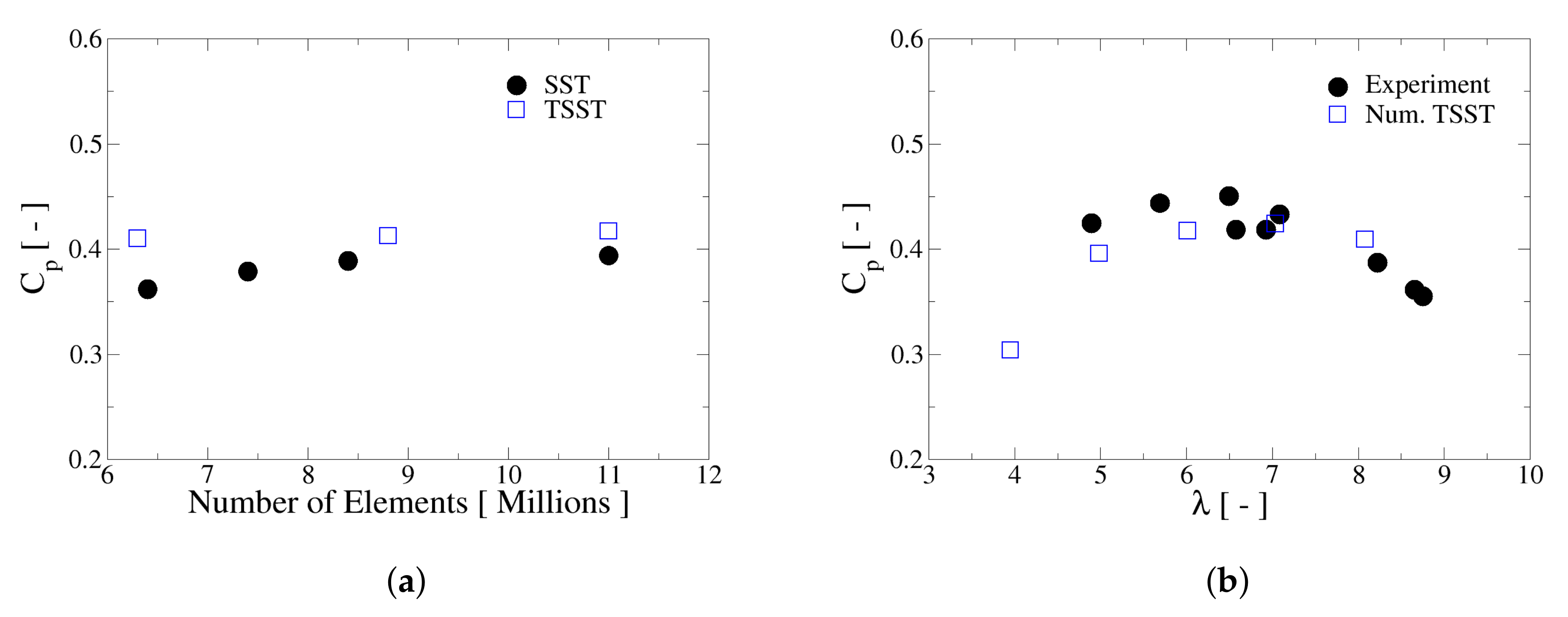



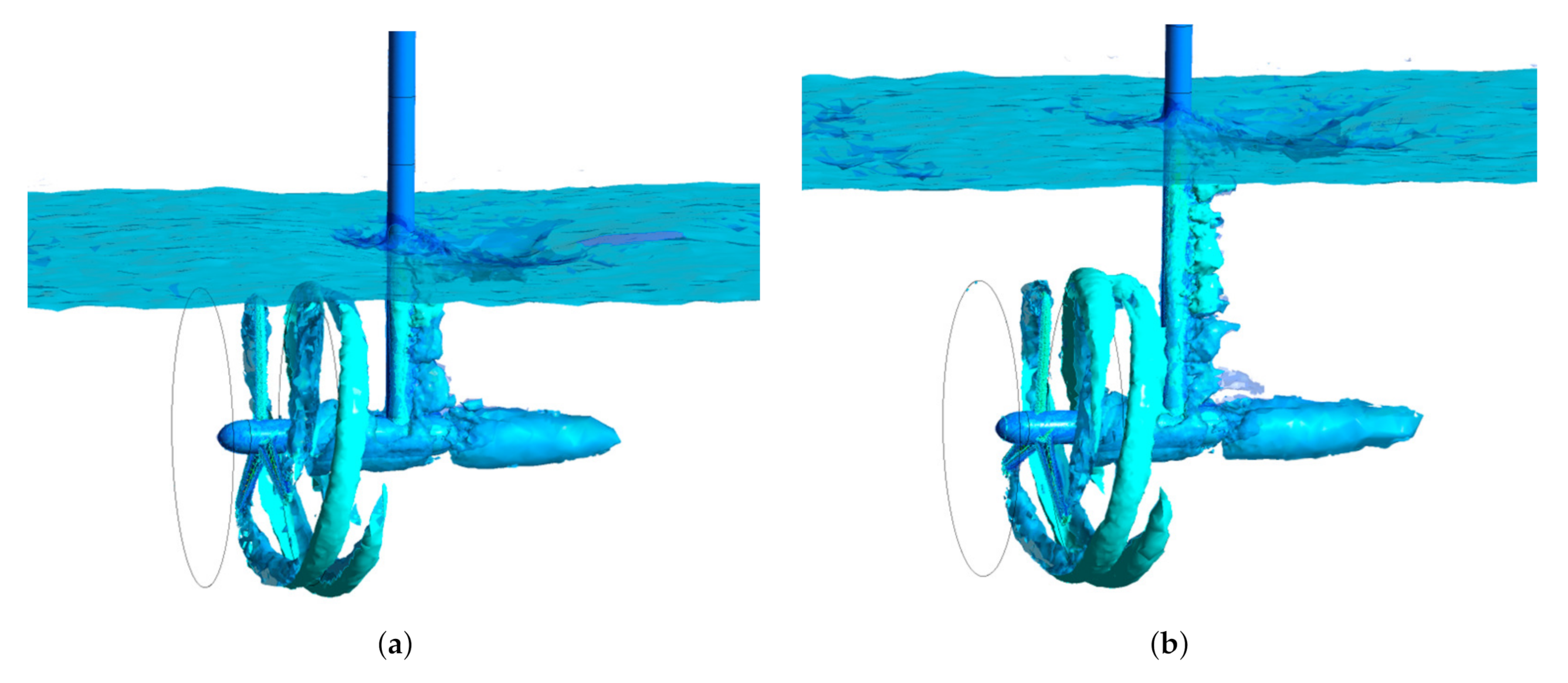


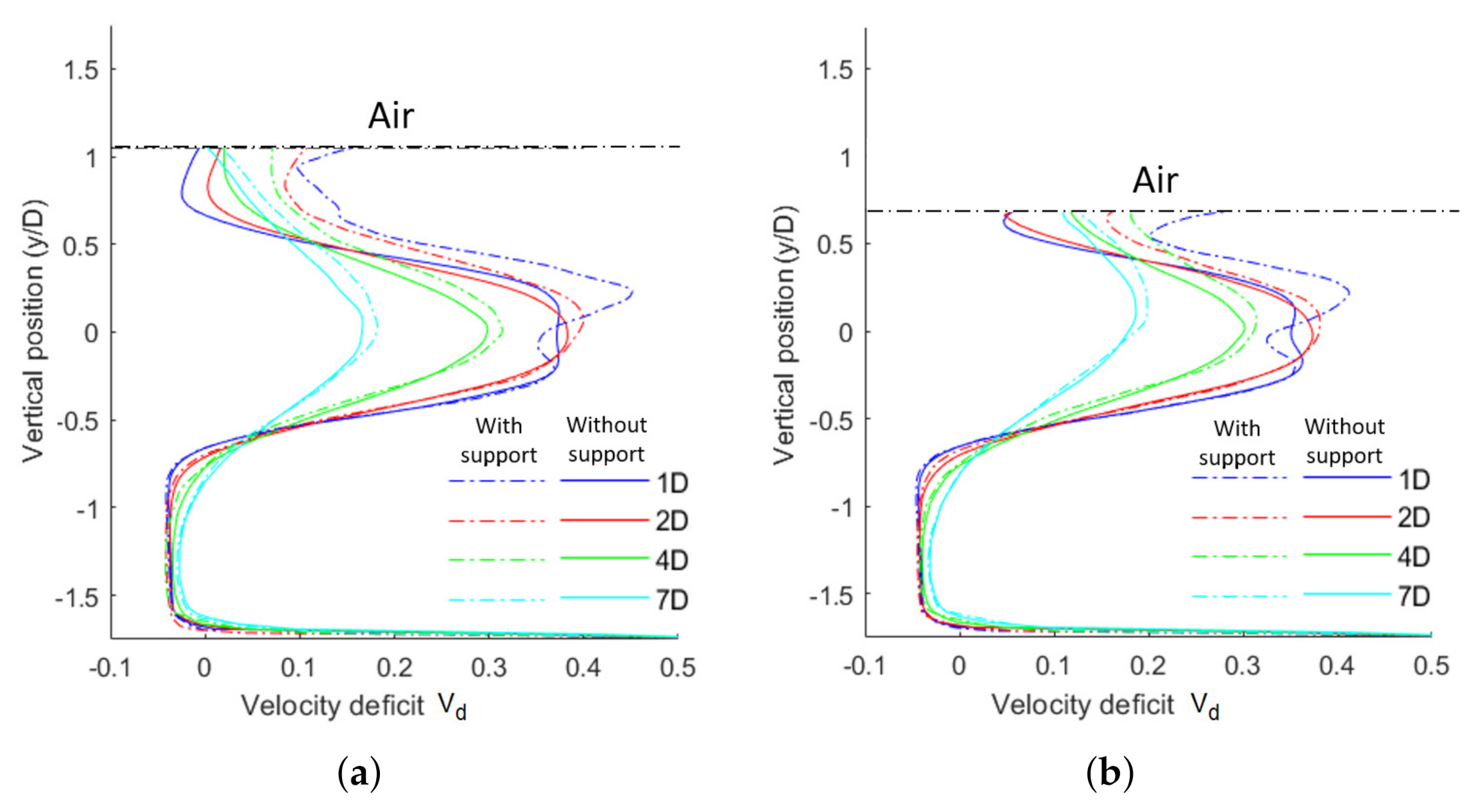
| Case | Modeling Approach | Geometry | Blade-Tip Immersion |
|---|---|---|---|
| 1 | Single-phase flow | Rotor only | - |
| 2 | Two-phase flow | Rotor only | and |
| 3 | Two-phase flow | Rotor and support structure | and |
| Time Step (s) | Blade Rotation (°) | |
|---|---|---|
| 1.72 | 0.3982 | |
| 0.83 | 0.4015 | |
| 0.34 | 0.4034 |
Publisher’s Note: MDPI stays neutral with regard to jurisdictional claims in published maps and institutional affiliations. |
© 2021 by the authors. Licensee MDPI, Basel, Switzerland. This article is an open access article distributed under the terms and conditions of the Creative Commons Attribution (CC BY) license (https://creativecommons.org/licenses/by/4.0/).
Share and Cite
Benavides-Morán, A.; Rodríguez-Jaime, L.; Laín, S. Numerical Investigation of the Performance, Hydrodynamics, and Free-Surface Effects in Unsteady Flow of a Horizontal Axis Hydrokinetic Turbine. Processes 2022, 10, 69. https://doi.org/10.3390/pr10010069
Benavides-Morán A, Rodríguez-Jaime L, Laín S. Numerical Investigation of the Performance, Hydrodynamics, and Free-Surface Effects in Unsteady Flow of a Horizontal Axis Hydrokinetic Turbine. Processes. 2022; 10(1):69. https://doi.org/10.3390/pr10010069
Chicago/Turabian StyleBenavides-Morán, Aldo, Luis Rodríguez-Jaime, and Santiago Laín. 2022. "Numerical Investigation of the Performance, Hydrodynamics, and Free-Surface Effects in Unsteady Flow of a Horizontal Axis Hydrokinetic Turbine" Processes 10, no. 1: 69. https://doi.org/10.3390/pr10010069






